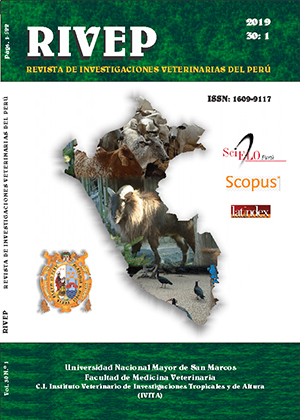Fermentative quality of liquid silage of peach palm (Bactris gasipaes) treated with natural yoghurt, whey and molasses
DOI:
https://doi.org/10.15381/rivep.v30i1.15672Keywords:
alternative feed; Bactris gasipaes; pigs; liquid fermentationAbstract
The aim of this study was to evaluate the effects of the addition of natural yoghurt, whey and molasses in liquid silages of peach palm (Bactris gasipaes) on physicochemical, biological and organoleptic indicators for use in animal feed. Three silages were used using the mature drupe of the plant: peach palm with natural yogurt (CYN), peach palm with whey (CSL), and peach palm with milk whey and molasses (CSLM). Thirty microsilos were prepared per treatment of 1 kg each, which were evaluated on days 1, 4, 8, 15, 30 and 60 of the start of the conservation process (five per treatment). The variables studied were temperature, pH, presence of bacteria (E. coli, Clostridium spp, Salmonella spp), smell, color and consistency. Higher temperatures were found in CYN (22.56 °C) and CSLM (22.52 °C) on day 1, CYN (22.48 °C) and CSL (22.42 °C) on day 15, CYN (22.50 °C) on day 30, and CYN (22.46 °C) and CSL (22.34 °C) on day 60 (p<0.05). The highest pH values were observed in CYN (4.82) on day 1 and day 4 (4.49) as compared to the other treatments (p<0.05). CSLM had the lowest pH between days 8 and 60 (4.19-4.17) (p<0.05). There was no presence of the bacteria under study in none of the treatments. The silages presented sweet fermented odor, yellowish brown color and semi-hard consistency in all evaluations. The three liquid silages of peach palm drupes presented adequate physicochemical, microbiological and organoleptic characteristics until day 60, all suitable for animal feeding.
Downloads
Downloads
Published
Issue
Section
License
Copyright (c) 2019 Juan Carlos Moyano, Willan Orlando Caicedo, Segundo Benedicto Valle, Luis Antonio Díaz, María Eduarda Caicedo

This work is licensed under a Creative Commons Attribution-NonCommercial-ShareAlike 4.0 International License.
AUTHORS RETAIN THEIR RIGHTS:
a. Authors retain their trade mark rights and patent, and also on any process or procedure described in the article.
b. Authors retain their right to share, copy, distribute, perform and publicly communicate their article (eg, to place their article in an institutional repository or publish it in a book), with an acknowledgment of its initial publication in the Revista de Investigaciones Veterinarias del Perú (RIVEP).
c. Authors retain theirs right to make a subsequent publication of their work, to use the article or any part thereof (eg a compilation of his papers, lecture notes, thesis, or a book), always indicating the source of publication (the originator of the work, journal, volume, number and date).



